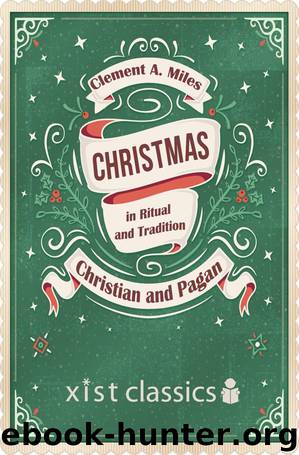Christmas in Ritual and Tradition Christian and Pagan by Clement A. Miles

Author:Clement A. Miles [Miles, Clement A.]
Language: eng
Format: epub
Publisher: Xist Publishing
Published: 2016-09-21T07:00:00+00:00
* * *
CHAPTER IX CHRISTMAS EVE AND THE TWELVE DAYS
Christkind, Santa Klaus, and Knecht Ruprecht —Talking Animals and other Wonders of Christmas Eve —Scandinavian Beliefs about Trolls and the Return of the Dead —Traditional Christmas Songs in Eastern Europe —The Twelve Days, their Christian Origin and Pagan Superstitions —The Raging Host —Hints of Supernatural Visitors in England —The German Frauen —The Greek Kallikantzaroi.
CHRISTMAS EVE IN DEVONSHIRE —THE MUMMERS COMING IN
Christmas Eve.
Christmas in the narrowest sense must be reckoned as beginning on the evening of December 24. Though Christmas Eve is not much observed in modern England, throughout the rest of Europe its importance so far as popular customs are concerned is far greater than that of the Day itself. Then in Germany the Christmas-tree is manifested in its glory; then, as in the England of the past, the Yule log is solemnly lighted in many lands; then often the most distinctive Christmas meal takes place.
We shall consider these and other institutions later; though they appear first on Christmas Eve, they belong more or less to the Twelve Days as a whole. Let us look first at the supernatural visitors, mimed by human beings, who delight the minds of children, especially in Germany, on the evening of December 24, and at the beliefs that hang around this most solemn night of the year.
First of all, the activities of St. Nicholas are not confined to his own festival; he often appears on Christmas Eve. We have already seen how he is attended by various companions, including 230Christ Himself, and how he comes now vested as a bishop, now as a masked and shaggy figure. The names and attributes of the Christmas and Advent visitors are rather confused, but on the whole it may be said that in Protestant north Germany the episcopal St. Nicholas and his Eve have been replaced by Christmas Eve and the Christ Child, while the name Klas has become attached to various unsaintly forms appearing at or shortly before Christmas.
We can trace a deliberate substitution of the Christ Child for St. Nicholas as the bringer of gifts. In the early seventeenth century a Protestant pastor is found complaining that parents put presents in their children's beds and tell them that St. Nicholas has brought them. “This,” he says, “is a bad custom, because it points children to the saint, while yet we know that not St. Nicholas but the holy Christ Child gives us all good things for body and soul, and He alone it is whom we ought to call upon.” 1}
The ways in which the figure, or at all events the name, of Christ Himself, is introduced into German Christmas customs, are often surprising. The Christ Child, “Christkind,” so familiar to German children, has now become a sort of mythical figure, a product of sentiment and imagination working so freely as almost to forget the sacred character of the original. Christkind bears little resemblance to the Infant of Bethlehem; he is quite a tall child, and is often represented by a girl dressed in white, with long fair hair.
Download
This site does not store any files on its server. We only index and link to content provided by other sites. Please contact the content providers to delete copyright contents if any and email us, we'll remove relevant links or contents immediately.
| Christmas | Easter & Lent |
The 5 Love Languages: The Secret to Love That Lasts by Gary Chapman(8494)
The Space Between by Michelle L. Teichman(6088)
Assassin’s Fate by Robin Hobb(5236)
Wiseguy by Nicholas Pileggi(4586)
Everything Happens for a Reason by Kate Bowler(4067)
Gerald's Game by Stephen King(3918)
A Simplified Life by Emily Ley(3569)
The Power of Positive Thinking by Norman Vincent Peale(3448)
Pillow Thoughts by Courtney Peppernell(3395)
Resisting Happiness by Matthew Kelly(2886)
Girl, Wash Your Face by Rachel Hollis(2821)
Being Aware of Being Aware by Rupert Spira(2706)
Name Book, The: Over 10,000 Names--Their Meanings, Origins, and Spiritual Significance by Astoria Dorothy(2490)
Real Sex by Lauren F. Winner(2474)
More Language of Letting Go: 366 New Daily Meditations by Melody Beattie(2443)
The Holy Spirit by Billy Graham(2417)
Fast Facts on Defending Your Faith by John Ankerberg & John Weldon(2388)
Victory over the Darkness by Neil T. Anderson(2386)
The Secret Power of Speaking God's Word by Joyce Meyer(2253)
